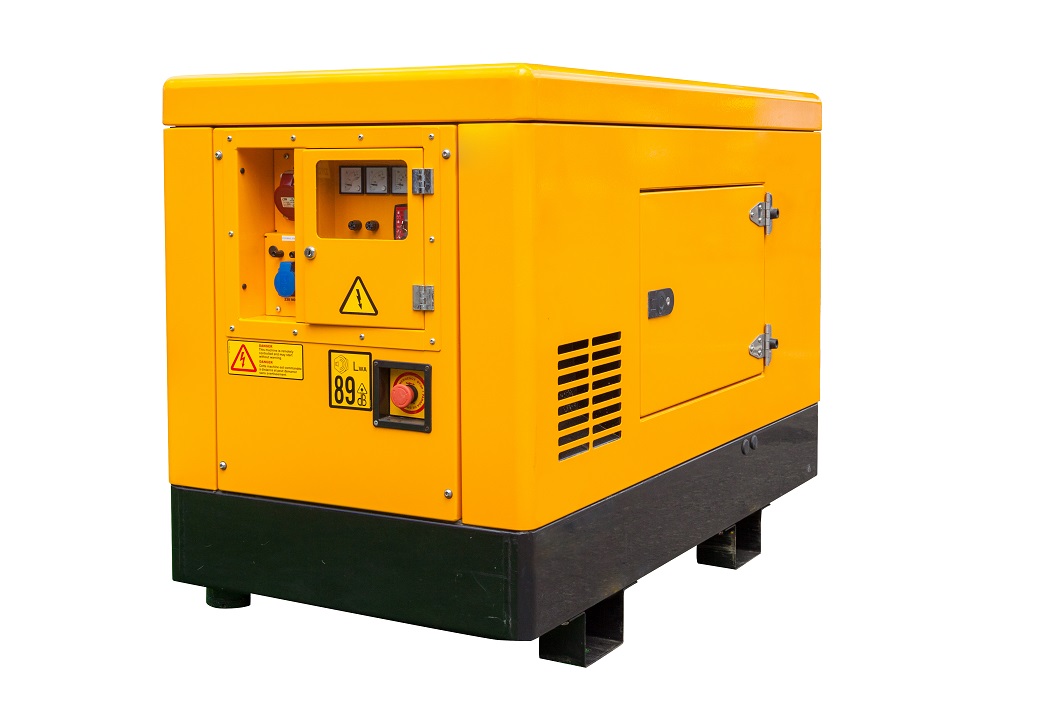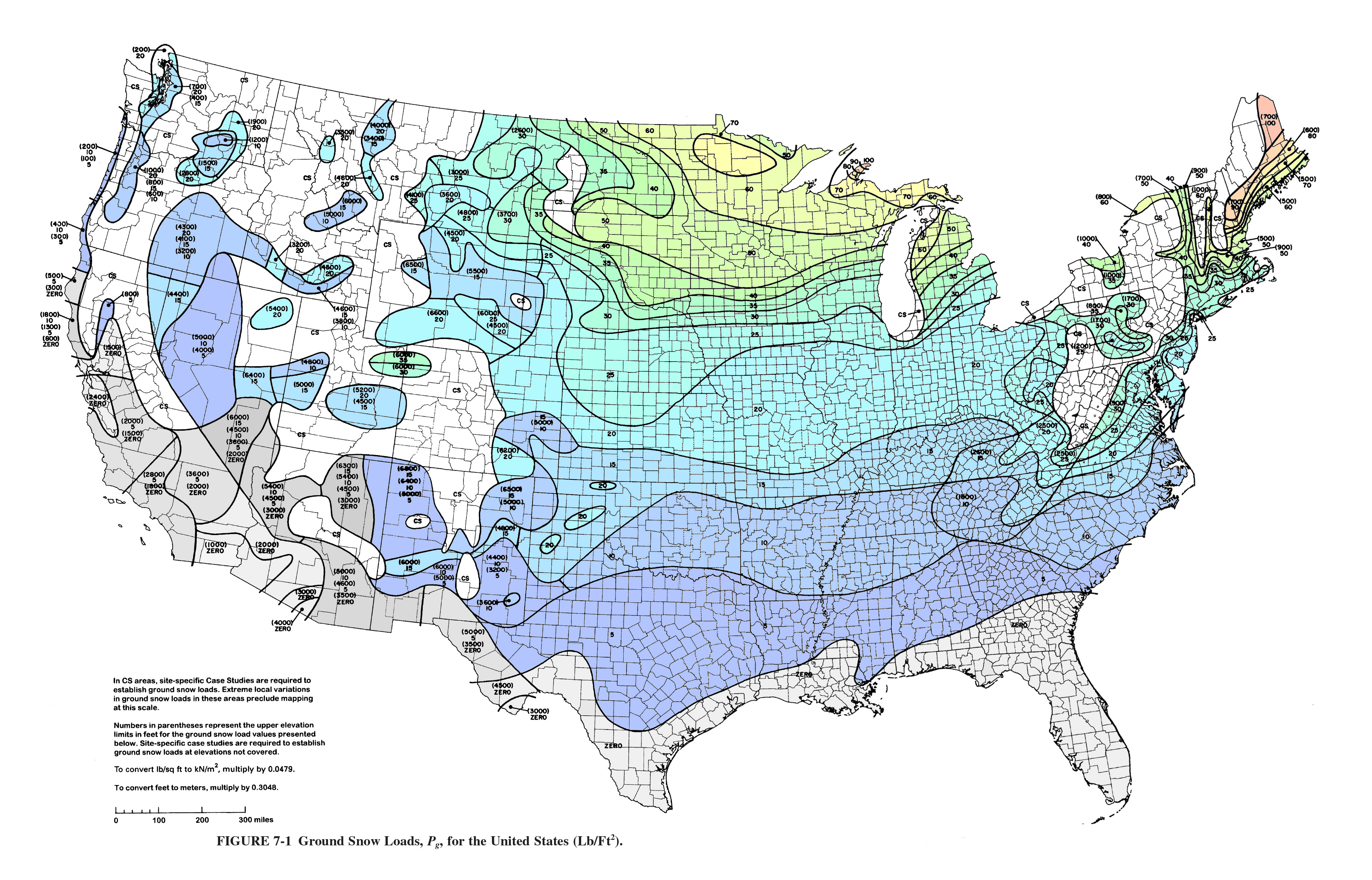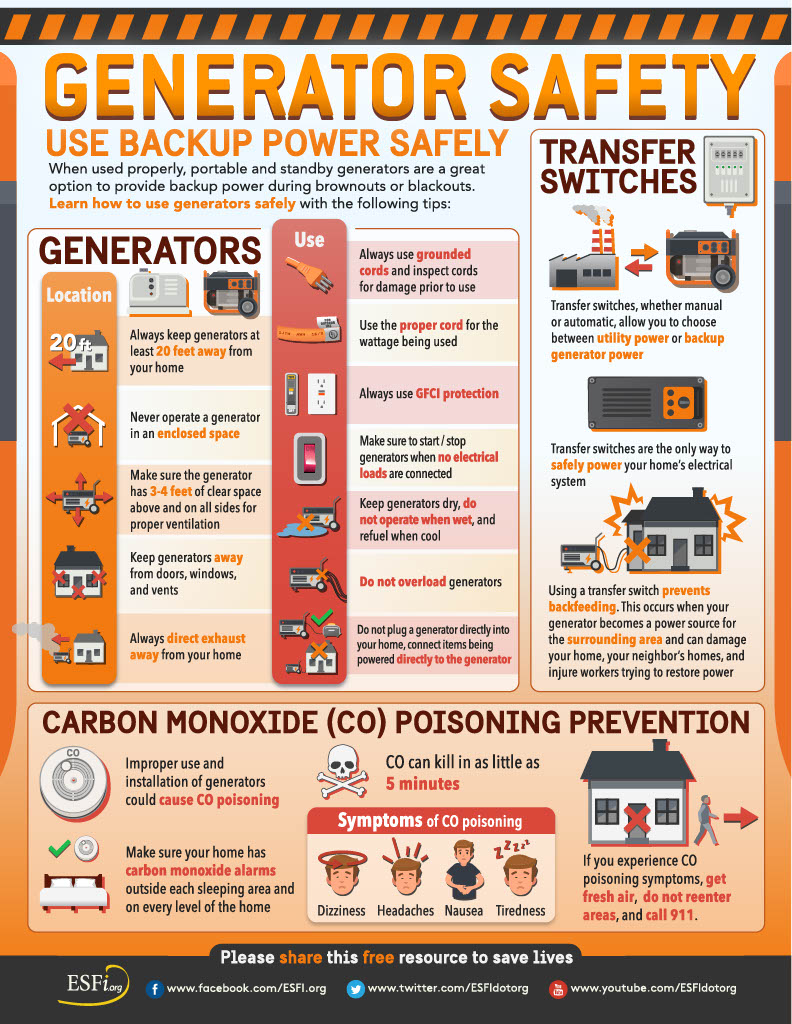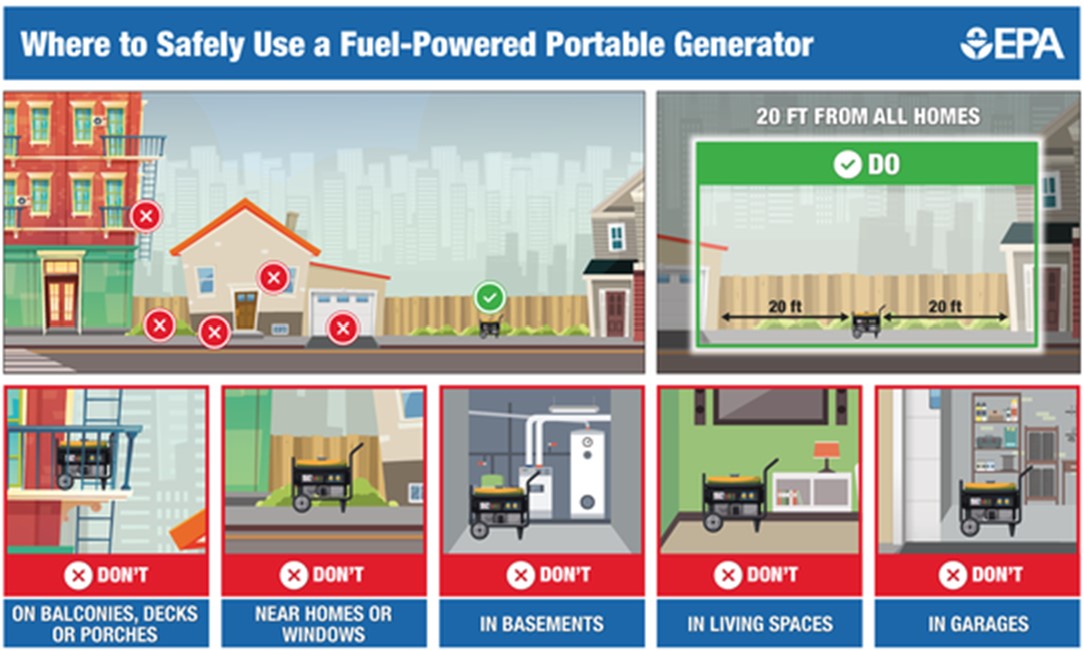Severe weather events and grid disruptions can often cause power outages. As we hear about extreme weather events with increasing frequency (WMO 2021, CARB 2021, CDC 2021), more households are turning to generators as a back-up source of power.
A portable generator (Figure 1) can help individual households span power outages by producing enough electricity to run circuits for critical needs such as heating and cooling, refrigeration, cooking, medical equipment, water pumps, telephone charging, etc.

When severe winter weather events interrupt or shut down the electric utility grid, backup power using a portable generator is a relatively affordable resiliency strategy. Generators burn propane, gasoline, or diesel fuel and give off carbon monoxide. They should never be operated inside the home, the garage, or a basement. They should be operated outdoors at least twenty feet away from the home and protected from falling snow and rain by an open structure with a roof or a vented covered enclosure. If in an area of high snow fall, they should be installed on a platform above anticipated snow levels. The generator can be run off a small portable tank. Some households, especially rural households, install large fuel tanks on site. Fuel stabilizers may need to be added to the tank to prevent spoilage over time. Another option is to permanently hook up the generator to the home’s natural gas line.
There are a few ways to attach a generator to the home’s electrical system. A manual transfer switch (also called a transfer panel) can be installed by an electrician adjacent to the electrical panel. Only key circuits such as the furnace, water pump, refrigerator, and select lights and receptacles that will be powered by the generator are wired from the main electric panel to this transfer switch panel. This transfer panel is wired to an outlet that has a plug that will accept a cable from the generator; the outlet is located on the outside of the house near where the portable generator will be set up. The transfer panel has a switch on it that switches power from the grid to the generator. Or, the electrician can set up the electric panel with an interlock. The outside power outlet for the generator goes to a generator on/off switch in the main electrical box. When the generator switch is turned on, it will feed the entire electric panel and the homeowner decides which circuits they want to run. To operate the generator if the power goes off, the homeowner would turn off all the switches in the electric panel, turn off the main breaker, slide the interlock mechanism out of the way, flip the generator to on, then turn back on only those switches for critical circuits like heating, water pump, and refrigerator. If they turn on too many switches, the portable generator will typically shut off. When using portable generators, sizing the load rating of the cord to the generator is important, and the required amperage should be labeled so that homeowners will purchase the correct cord.
Another method of connecting to an exterior generator is a socket-mounted transfer switch shaped like a cylinder that fits on the exterior of the house between the meter and the meter base; a cable from the generator plugs directly into an outlet on this cylinder. While hardware costs for commercially available units are comparable or slightly more than panel-mounted transfer switch, the installation costs are very low as it takes less time for an electrician to install the cylinder than to install the transfer switch and power outlet. The switch keeps generator power from going to the grid or to the panel when grid power is on. When the grid is down and the generator is operating, the unit provides power to the electric panel but it likely will not provide enough power to run all circuits so the homeowner needs to manually switch off some circuits so as not to exceed the capacity of the generator. Not all jurisdictions have approved this type of system because it is a relatively recent technology; therefore, it is important to check with the local electrical authority before installing one.
Contractors can help homeowners prepare in advance for temporary outages by recommending, installing, connecting and testing a portable generator to be ready for these events. Many local utilities provide guidance and several offer rebates or tax credits for installing temporary power devices. All home power generation requires strict disconnect controls to isolate the home generation system from the grid to ensure the safety of utility workers.
Generator Options
Portable, temporary power for emergency response can be provided by a variety of devices:
- Fossil-fuel generators could be small portable units (Figure 1) for temporary use to run a few circuits or larger permanently installed units (Figure 2) that can handle the power needs of the whole-house; these larger units are more common for homes in rural locations or locations that experience more frequent power outages. Both types come in models that use natural gas, gasoline, diesel, or liquid propane. These require stores of fuel safely sited outside in quantities appropriate to the homeowner’s usage needs and projected outage time spans.
- Portable, rechargeable battery/inverter units, which can be pre-charged using grid power and re-charged using solar panels or other renewable sources (small wind or micro-hydro)
- Permanent household battery backup/inverter systems, (which may include electric vehicles) that can store charge from either the grid or renewable sources on site such as rooftop solar panels or a home wind turbine, or a combination of grid and home-produced renewable power.

Generator Selection
Typical contractor activities to aid a homeowner in developing a backup power solution include the following:
- Conduct a survey of existing conditions to help the homeowner identify needs and decide which generator best suits their needs and budget.
- Do they own or rent their home?
- Do they own or plan to purchase photovoltaic panels or another renewable resource in the near future?
- Do they want complete household back-up (a permanent installation) or will powering a subset of devices be adequate (a portable or semi-portable unit)?
- What is their budget?
- Do they require financing or low and middle income (LMI) assistance? Several private and public entities provide guidance, financing, and access to community purchasing programs – check out what’s available in your area
- What are their concerns about operation, maintenance, and safety?
- Do they have outdoor space to safely install a fossil fuel generator and fuel storage tank?
- Develop a schematic of appliances, equipment, capabilities, or locations that may require temporary power.
- Recommend a power capacity to meet the homeowner’s needs.
- Engage a licensed electrical contractor to design, permit, and install generator circuitry to interconnect with the household breaker box with a transfer switch that prevents backfeeding; to rewire circuits if necessary to group emergency needs; to upgrade wiring and/or breakers if necessary; and to include manual switching and automatic safety controls as required.
Generator Installation
For permanent fossil fuel generators:
- Confirm flooding is unlikely – whole-house fossil fuel generators should not be installed in flood-prone areas.
- Determine the availability of fuel types in the area.
- Review whether tanker trucks can access the site to deliver fuel.
- Locate and mark a site for the generator and fuel tank, including excavation and compaction of the soil and construction of a concrete pad.
- In high snow load regions (Figure 3), install the generator on an elevated platform, above expected snow height.
- In areas that experience seasonal flooding, elevate the pad above the base flood elevation. Also locate it away from swales that might be inundated by clogged storm drains or excessive rainfall.
- The generator platform should be outdoors at least twenty feet away from the home. Site both the generator and the fuel tank at least 20 feet from the home and from each other
- Construct a shelter on the pad to protect the generator from the snow and rain. The shelter should have a roof and open or removable, vented sides to protect the generator from falling snow and rain.
- Avoid dangerous generator locations (Figure 5).

- Protect homeowners and occupants from carbon monoxide poisoning as follows:
- Keep the generator at least 20 ft from the home.
- Face the exhaust of the generator away from the house.
- Install carbon monoxide detectors and indoor air quality monitors in the home (for direct exhaust issues and also for homeowners who may operate combustion space heaters or uncleaned fireplaces in the home during power outages).
- Engage an electrician to install safe and reliable transfer switches (manual or automatic) to allow the homeowner to choose between utility power or backup generator power and to prevent backfeeding. Choose one of the following switch types:
- a manual transfer switch adjacent to the main electrical panel
- an interlock on the main panel
- a socket-mounted transfer switch.
- Provide information to the homeowner on safe generator operation and maintenance requirements, including a regular testing schedule and the need to maintain safe access and operation of both the generator and fuel storage tank. Especially note the importance of clearing weeds, grasses, and debris around the generator to remove combustion sources. Many utilities, extension services, and local governments provide guidance for the safe use and operation of generators, such as the factsheet in Figure 4 from the Electrical Safety Foundation International (ESFI). Click here to find a variety of web articles on the topic: https://www.esfi.org/?s=generators.


More Info
The following authors and organizations contributed to the content in this Guide.